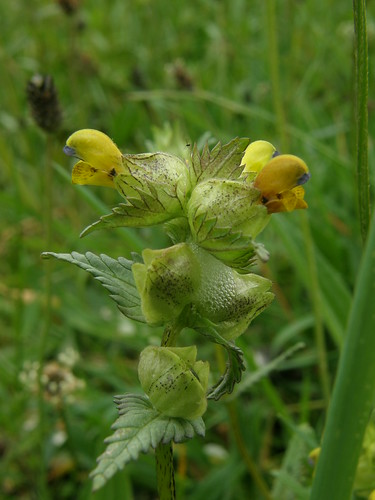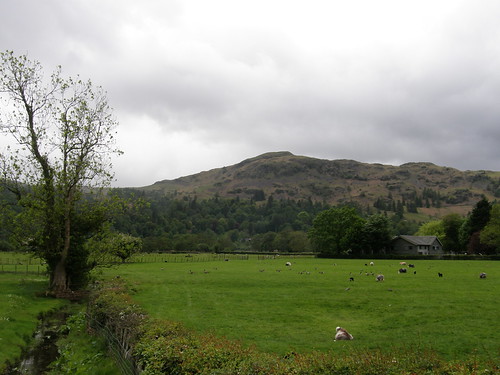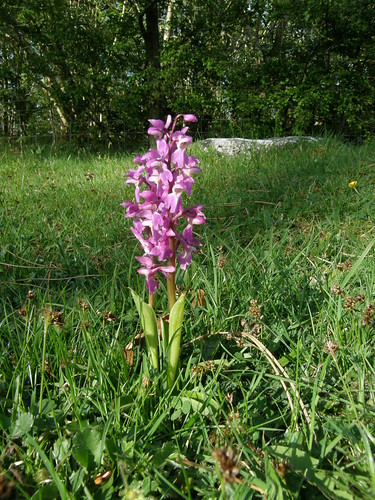
Every Wednesday a Silverdale Events Update lands in my inbox, a listing of what’s on offer each week in our little community, which since there is often a lot going on is an excellent thing to have. Especially if what’s on offer is:
Saturday 21 May 9.30am Jenny Brown’s Point
Beating of the Bounds
Join the public party on this historic walk around the boundary of Silverdale village.
Wear suitable clothing, bring a packed lunch and drinks.
Return to Gaskell Hall at approx. 4pm for refreshments
As you can imagine, I’ve been looking forward to this for quite some time. A was keen too and can be seen here with the gathering crowd, waiting for the off, not at Jenny Brown’s Point in fact but by the chimney which is all that’s left of a former copper smelting works.
But I’m getting ahead of myself. A and I had already had a bit of a walk by this point having come down by Woodwell and through Jack Scout. In A’s little rucksack she had a mountain of sugary snacks, a drink, a small picnic rug and a camera. When we stopped to find the source of a very musical serenade….

…,a song thrush atop a telegraph pole, I think that she may have reached for her camera even before I started snapping away with mine. With a school project on ‘minibeasts’ to complete she spent much of the day looking for creepy crawlies to photograph. Like a chip of the old block!
By the time we were passing through Jack Scout I was concerned that we might be late arriving at the start, but then we saw…

…the flag party arriving from their earlier start at Bard’s Well.

In the end, the start wasn’t quite 9.30, but we eventually set-off across Quaker’s Stang…

When we reached the road, the flag party left us, as they would often do through the day, to follow the parish boundary as closely as possible across private land…

…sending as they did so a large flock of geese wheeling into the air in alarm.
The rest of, meanwhile, had a police escort along the road…

…to Leighton Moss for a first rest stop, tea and snacks in the cafe, or on the benches in the car park. If you know the area you will know that we hadn’t walked very far at this point. This was going to be a leisurely affair. Still, I have nothing against plentiful and lengthy stops on my walks. I drank some tea and enjoyed the antics on the birdfeeders of a woodpecker and a squirrel.
We walked a little further along the road to a boundary stone…


Apparently it’s traditional to beat the boundary markers with sticks, or possibly to beat small boys with sticks near the boundary markers (perhaps that’s why only one small boy was brave enough to accompany us). There was none of that. Nor any poles decorated with milkwort, but there were some appropriate prayers said hear by the stone. I have no idea what the symbol on the stone signifies.
Shortly after we stopped at Trowbarrow Quarry for an early lunch break. A and I watched a jackdaw squeezing in and out of a narrow fissure in the quarry wall, presumably to and from a nest.
Walking along Moss Lane, to meet the flag party who have taken a more direct line along the boundary towards Haweswater, my eye was caught by a flash of brightness in the hedge.

A yellow-tail moth caterpillar. We once hosted a shoebox home for a group of these little wrigglers. I’m not sure that I ever told the sequel to that tale: when we returned the box to the kids school it was one short of occupants and a few weeks later our kitchen cupboards were graced by an adult moth. Not sure where it pupated.

Walkers and cow parsley on Moss Lane.
On the boardwalks by Haweswater I was dragged from another conversation by this amazing gold bug…

which is a leaf beetle, Donacia Vulgaris. There’s a goldbug in an Edgar Alan Poe story is there not? Fortunately this one didn’t bite me, although I reserve the right to obsessively search for hidden treasures. Like these….

…bird’s-eye primroses.

We passed the cloven ash and walked alongside Silverdale Moss. We waited a while for the flag party….

I kept busy photographing the flowers in the meadow. This rather fine display is from…

…mouse-ear-hawkweed. I usually throw my hands up in despair when faced with yellow daisies to identify, but I thought the very distinctive silvered and hairy leaves…

…might prove to be a good clue – and they were.

When I tried to photograph some yellow rattle…

I was interrupted when this…

…alderfly landed on my camera’s strap.
With still no sign of the flag party, we decided to detour slightly to visit Coldwell Limeworks…

This area too was full of distractions…

Speedwell.

Pyrochroa serraticcornis.

Gall on lime leaf.
When the flag party emerged form the trees, looking a little bedraggled, we set off again. Once again, the boundary doesn’t have a path, but permission must have been granted for the entire party to stick to the proper route here and we followed the edge of Silverdale Moss.

There were lots of yellow flag, but whilst I was trying to get close enough for a photo, without being close enough to get wet, I was distracted by….

…a much less spectacular but distinctive plant, with a very stout stem and thick fleshy leaves…

….which is celery-leaved buttercup. And now I’m feeling very pleased with myself because I’ve identified both a yellow daisy and a buttercup. I’m still fighting shy of the speedwells I know, but the flower key is definitely working for me.

Arnside Tower.

Silverdale Moss.

And another chance to press Fitter, Fitter and Farrer into service with marsh horsetail.

At Middlebarrow quarry the kids briefly got their hands on the flag…

A and her friend B (our B was at a Birthday party).
We entered Eaves Wood – passing the patch of lily-of-the-valley which I mentioned in my last post – and then climbed to cross the high part of the hill. B pointed out some roe deer to us, but as usual they were long go before I had my camera ready.
When we reached the Cove the bad weather which had been forecast finally began to make an appearance with a few spots of rain. In the Lots the early purple orchids were finished the flowers looking blackened and burned. The green-winged orchids weren’t so advanced however…


The flag party had taken a longer route and we waited for them at the Gaskell Hall (named for the writer Elizabeth Gaskell) and enjoyed a slideshow and a cup of tea…

By the time the flag party arrived the rain had begun in earnest and they looked very wet.
I heard various distances bandied about during the walk, but the consensus of opinions seemed to plump for about 11 miles. My pedometer gave just under 10 miles, but that included walking to the start and finish. Bing maps gave just over 7 miles for the route shown above. Take your pick, it’s a nice walk however long it is.


































































































